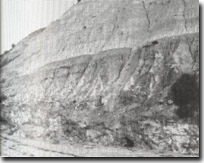26 Beacon Point Road - Geological Site
|
This information has been developed from one or more of these publications:
|
| Location | 875754. Cliff at the northern end of Beacon Point Road. |  Site 26, Moorabool Viaduct Sand (upper part of cliff) and Fyansford Formation (lower) at Beacon Point Road geological site |
Access | Beacon Point Road. | |
Ownership/Managing Authority | Crown land (Port of Geelong Authority) below high water mark; private land above high water mark. | |
Site Description | The 10 m high active cliff exposes a detailed geological section of the Fyansford Formation, Moorabool Viaduct Sand and the overlying silty clay formation. There are marked changes in colour, texture, composition and degree of weathering of the materials. The cliff is notched at the base and the profile above this reflects the differences in weathering resistance of the sedimentary materials. | |
Significance | Regional. The site is a clear display of the Tertiary sedimentary formations that comprise the Bellarine Peninsula. The varied laterization and calcareous induration of the Moorabool Viaduct Sand is particularly well represented here. The site is an excellent example of an active coastal cliff showing differential materials to weathering and erosion. It is easily and safely accessible. | |
Management Considerations | Class 1. No protective structures or boulder walls should be built at the cliff base, as this would cause a build-up of slumping and downwash materials that would obscure the details of the section. The cliff should be retained as an active and dynamic feature. It follows that the siting of cliff-top structures should take account of the likely rate and direction of cliff recession. Some basic research would evaluate this figure. | |
References | Ladd, P.G. (1971) | |

Site 26, Beacon Point Road geological site


